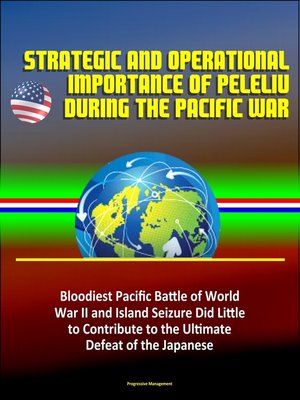Strategic and Operational Importance of Peleliu During the Pacific War
ebook ∣ Bloodiest Pacific Battle of World War II and Island Seizure Did Little to Contribute to the Ultimate Defeat of the Japanese
By Progressive Management

Sign up to save your library
With an OverDrive account, you can save your favorite libraries for at-a-glance information about availability. Find out more about OverDrive accounts.
Find this title in Libby, the library reading app by OverDrive.



Search for a digital library with this title
Title found at these libraries:
| Library Name | Distance |
|---|---|
| Loading... |
Professionally converted for accurate flowing-text e-book format reproduction, this unique book examines the idea that the operational decision to seize the island of Peleliu did little to affect the US strategic goal and outcome of the Pacific War during World War II.
Discussion: The Empire of Japan was now on the defense but its quest for power and resources had spread its military might throughout the vast regions of the Pacific islands and Far East. Maintaining key operational and logistical bases throughout the Pacific chain of islands was crucial to Japanese overall support for its war effort. By expanding its empire, Japan had formed a powerful defensive belt around its homeland. In order for the US to reach its strategic goal of the ultimate defeat of the Japanese, it was necessary to commence a full-scale assault throughout the Pacific to close in on the homeland. The island hopping strategy as it became known was the only means to array US forces closer to the mainland objective. Many islands were seized throughout the central and southern Pacific area of operations in order to neutralize Japanese strongholds and gain logistical support bases to carry on with the Pacific campaign. Many analyst and historians claim certain islands seized were a terrible loss of life without any significant strategic and operational advantages to US goals at the time; the seizure of the island of Peleliu fell into this claim. This study seeks to examine the operational necessity in seizing the island of Peleliu (Operation Stalemate II), decisions involved, and assess whether or not its seizure enhanced the US strategic goal of defeating the Japanese.
Conclusion: Seizing the island of Peleliu did little to change or contribute to the ultimate defeat of the Japanese during World War II. US war planners had the opportunity to revisit their course of action but chose not to alter their original plans. Island by-pass criteria should have been more closely examined and studied. As a result, many servicemen lives were lost as the battle of Peleliu was marked as one of the bloodiest battles in the Pacific.







